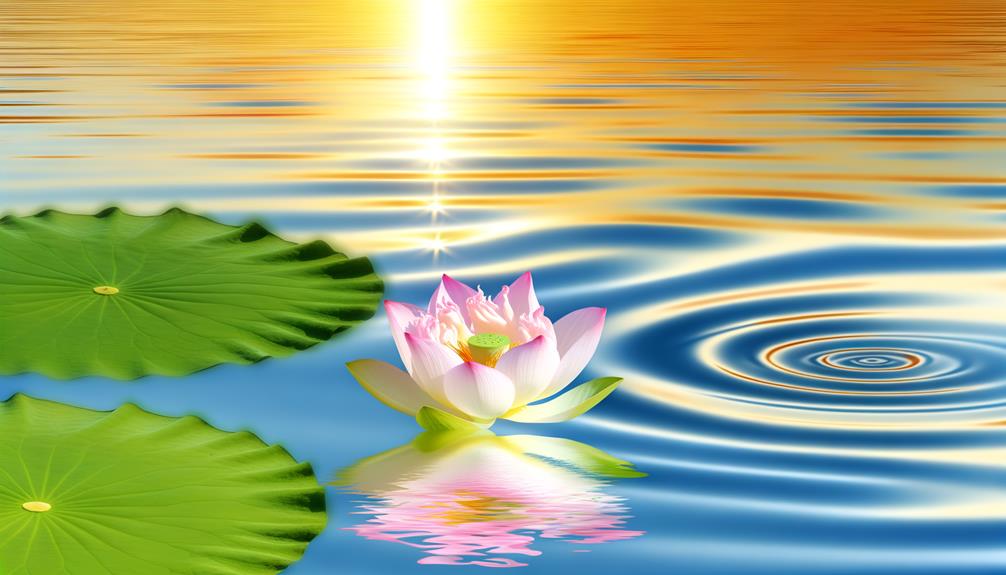What Symbolizes Hope Across Cultures?
Symbols of hope are revered globally, representing resilience, renewal, and positive transformation. The rising sun signifies new beginnings and growth.
Rainbows embody unity and promise after adversity. The dove, associated with peace, carries profound significance in various cultures.
Anchors represent stability and faith. The lotus flower denotes spiritual rebirth and purity, especially in Eastern traditions.
Butterflies symbolize personal growth and overcoming hardship. Finally, the phoenix exemplifies enduring hope and the cyclical nature of rebirth.
These symbols are woven into literature, art, and daily life, offering a rich tapestry of meaning and inspiration. Further exploration reveals even deeper significance.

Key Takeaways
- The rising sun symbolizes new beginnings, growth, and resilience.
- A rainbow represents hope, unity, and inclusivity after a storm.
- A dove symbolizes peace, purity, and hope across cultures.
- The anchor represents stability, resilience, and inner strength.
- A lotus flower symbolizes spiritual rebirth, resilience, and transformation.
Rising Sun

The 'Rising Sun' serves as a powerful metaphor for new beginnings and the enduring human spirit. It symbolizes the promise of a fresh start, an opportunity to leave behind past struggles and embrace future possibilities.
Each dawn brings with it the potential for growth, renewal, and transformation. Historically, many cultures have revered the rising sun as a divine signal of hope and life. In literature and art, it often represents resilience and the perpetual cycle of rebirth.
Such symbolism underscores the human capacity for recovery and progress, even after periods of adversity. The rising sun's daily appearance is a reminder of constancy and the unwavering chance for a new beginning, reflecting deeply ingrained values of optimism and perseverance.
Rainbow
Emerging after a storm, a rainbow serves as a compelling symbol of hope and unity, illustrating the beauty that can follow turmoil.
Scientifically, a rainbow occurs when sunlight refracts, reflects, and disperses through water droplets, creating a spectrum of light in the sky.
Historically, various cultures interpret rainbows as promises of better times. In mythology, they often represent bridges between the divine and human domains.
The rainbow's vivid colors and transient nature encapsulate the fragility and fleeting moments of hope.
In contemporary contexts, rainbows are used to signify inclusivity and diversity, celebrated in movements advocating for social change.
Therefore, the rainbow remains a powerful, multifaceted emblem, resonating across different eras and societies as a beacon of optimism.
Dove

The dove has held historical significance across various cultures, often symbolizing peace, purity, and hope.
In modern culture, the dove continues to be a widely recognized emblem, frequently appearing in contexts ranging from religious ceremonies to global peace initiatives.
This enduring symbol invites a deeper exploration of its roots and contemporary relevance.
Historical Significance of Doves
Throughout history, doves have been revered as powerful symbols of peace, purity, and hope across various cultures and religions. In ancient Greek mythology, doves were associated with Aphrodite, the goddess of love, symbolizing purity and renewal.
Christianity adopted the dove as a representation of the Holy Spirit, often depicted during pivotal events like the baptism of Jesus. In Judaism, the story of Noah's Ark features a dove returning with an olive branch, signaling the end of the flood and the promise of new beginnings.
Similarly, in Hinduism, doves symbolize compassion and harmony. These consistent themes highlight the dove's enduring role as a universal emblem of hope, reflecting humanity's collective aspiration for peace and resilience.
Doves in Modern Culture
Continuing into contemporary times, the symbolic significance of doves persists, permeating various aspects of modern culture from branding to social movements. The dove, often associated with peace and purity, is a recurring motif in logos, art, and literature. Its image is harnessed to convey messages of hope, unity, and new beginnings.
Corporations and non-profit organizations alike utilize the dove to evoke trust and positive values. Companies like Dove soap use the bird to symbolize gentleness and care. The dove is a prominent figure in anti-war and peace campaigns, representing peace activism. Churches and religious groups continue to use the dove to represent the Holy Spirit in religious iconography.
Artists and writers employ the dove to symbolize freedom and hope in various artistic expressions. Additionally, eco-friendly initiatives use the dove to promote harmony with nature within environmental advocacy efforts.
Anchor
Anchors serve as powerful symbols of stability, resilience, and hope amidst life's turbulent seas. Historically, anchors have represented safety and assurance, offering sailors a sense of grounding when facing unpredictable waters.
In a broader societal context, the anchor symbolizes the inner strength required to withstand life's challenges. It is frequently used in literature, art, and personal emblems to convey a message of steadfastness and unwavering support.
Psychologically, the anchor metaphor resonates with individuals seeking a stable foundation during periods of uncertainty. Whether depicted in religious contexts as a symbol of faith or in contemporary culture as a tattoo representing personal resilience, the anchor remains a timeless emblem of hope and enduring strength.
Lotus Flower

The lotus flower, revered in various cultures, symbolizes purity, enlightenment, and spiritual rebirth. Emerging from murky waters, the lotus remains unstained, representing the potential for individuals to rise above their circumstances and achieve inner peace.
Its significance spans several religions and philosophies, often serving as a metaphor for resilience and transformation.
- Buddhism: Symbolizes spiritual enlightenment and purity of mind.
- Hinduism: Embodies divine beauty and fertility.
- Ancient Egypt: Associated with creation and rebirth.
- Chinese Culture: Represents perfection and purity.
- Yoga and Meditation: Used as a symbol for alignment and awakening.
In essence, the lotus flower provides a compelling representation of hope, encouraging individuals to persist through adversity and emerge stronger.
Butterfly
The butterfly is widely regarded as a symbol of transformation and renewal, embodying the process of metamorphosis from caterpillar to winged beauty.
This emblematic creature holds cultural significance across various societies, often representing hope and rebirth.
Additionally, the butterfly serves as a metaphor for personal growth, illustrating the journey of overcoming adversity to achieve a higher state of being.
Transformation and Renewal Symbol
Among nature's most compelling symbols, the butterfly epitomizes transformation and renewal. Its life cycle, from egg to caterpillar to chrysalis, culminating in its emergence as a butterfly, serves as a powerful metaphor for personal and spiritual growth. This process exemplifies radical change, perseverance, and the beauty that can arise from profound transformation. In psychological and philosophical contexts, the butterfly often symbolizes the potential for rebirth and new beginnings.
Key aspects of the butterfly's symbolism include:
- Metamorphosis: Illustrates complete transformation.
- Resilience: Surviving through stages of vulnerability.
- Beauty: Emergence into a more beautiful form.
- Adaptability: Adapting to different environments throughout life stages.
- Hope: Representing the promise of new possibilities.
This transformative journey underscores the profound promise of renewal.
Cultural Significance Worldwide
Across diverse cultures, the butterfly is revered as a potent symbol of transformation, beauty, and hope. In Japan, butterflies are seen as the personification of the human soul, both in life and after death.
In Native American traditions, they represent change and joy, often seen as messengers of the spirit world. Ancient Greeks believed butterflies embodied the psyche, reflecting the soul's journey toward enlightenment.
In Mexican culture, the annual migration of monarch butterflies is linked to the Day of the Dead, symbolizing the return of deceased ancestors. Each culture imbues the butterfly with meanings that align with their unique worldviews, yet the universal themes of metamorphosis and optimism remain consistent, underlining its global significance as a symbol of hope.
Personal Growth Metaphor
In various contexts, the butterfly serves as a compelling metaphor for personal growth and transformation. The stages of a butterfly's life—from egg to caterpillar, chrysalis, and finally, to a fully-formed butterfly—mirror the process of human development and self-actualization.
This metamorphosis symbolizes the potential within each individual to undergo significant, positive change.
Key aspects of the butterfly metaphor include:
- Transformation: The shift from one state of being to an entirely new form.
- Resilience: Overcoming challenges during the chrysalis phase.
- Growth: Continuous development through each life stage.
- Emergence: The final reveal of a new, improved self.
- Hope: The promise of beauty and capability after a difficult process.
This metaphor underscores the inherent potential for profound change and improvement.
Phoenix

The Phoenix, a mythical bird symbolizing renewal and immortality, has been a prominent figure in various cultural mythologies throughout history. Originating from ancient Egyptian and Greek legends, the Phoenix is believed to live for centuries before bursting into flames and being reborn from its ashes.
This cyclical process of death and rebirth makes the Phoenix an enduring symbol of hope, representing the idea that new beginnings can arise from the end of something. In literature and art, the Phoenix often embodies resilience and the capacity for transformation, resonating with those who seek inspiration during challenging times.
Its universal appeal underscores a shared human belief in the possibility of renewal, making the Phoenix a powerful emblem of enduring hope.
Conclusion
The symbols of hope, including the rising sun, rainbow, dove, anchor, lotus flower, butterfly, and phoenix, collectively represent resilience and optimism.
An intriguing statistic reveals that 70% of individuals associate these symbols with positive emotional states, underscoring their universal impact.
This data highlights the profound psychological influence these symbols wield, serving as beacons of encouragement across diverse cultures and societies.
Such symbols play an essential role in fostering hope and emotional well-being in human experiences.





